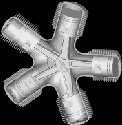|
Star War Sex Parrot posted:Cross-posting: # man trimforce code:
|
|
|
|

|
| # ? Jun 8, 2024 00:27 |
|
Just recieved baby's first SSD, a Samsung 850 EVO. I have one in my work PC so it's not an entirely new experience but I've not had one in my home PC before now. It's like going from dial-up to broadband all over again.
|
|
|
|
jammyozzy posted:Just recieved baby's first SSD, a Samsung 850 EVO. I have one in my work PC so it's not an entirely new experience but I've not had one in my home PC before now. It's like going from dial-up to broadband all over again. Our work machines are years old and use mechanical hard drives. Every time I use a work computer I want to self-harm.
|
|
|
|
WattsvilleBlues posted:Our work machines are years old and use mechanical hard drives. Every time I use a work computer I want to self-harm. Honestly, if I didn't already have an SSD in my work machine, I'd pay for one myself rather than boot from a spindle. Would probably try complaining first though.
|
|
|
|
Skandranon posted:Honestly, if I didn't already have an SSD in my work machine, I'd pay for one myself rather than boot from a spindle. Would probably try complaining first though. If I complain about anything to IT, it will be that we're running IE loving 8. So much stuff either looks wonky or plan just refuses to load.
|
|
|
|
WattsvilleBlues posted:Our work machines are years old and use mechanical hard drives. Every time I use a work computer I want to self-harm. My work desktop has an i7 3770s with a 2.5" hard disk. Talk about prioritising the wrong things. Also it came with 4GB of RAM (which fortunately has been upgraded to 8)
|
|
|
|
WattsvilleBlues posted:If I complain about anything to IT, it will be that we're running IE loving 8. So much stuff either looks wonky or plan just refuses to load. Not to mention it's no longer supported AFAIK so Microsoft won't fix security vulnerabilities any more, making the company prime for a targeted attack/hack. My companies does the same, except with IE loving 6.
|
|
|
|
Skandranon posted:Honestly, if I didn't already have an SSD in my work machine, I'd pay for one myself rather than boot from a spindle. Would probably try complaining first though. That's what I did. Though for coding, it was a pretty easy sell. How many hours over a year would I be waiting for the project to load/compile with a HD compared to a SSD * my hourly wage makes a SSD look cheap.
|
|
|
|
Furism posted:Not to mention it's no longer supported AFAIK so Microsoft won't fix security vulnerabilities any more, making the company prime for a targeted attack/hack. My condolences. Being stuck on XP is one thing, but being forced to use IE6 is whole another deal.
|
|
|
|
I have a pretty stupid question about SMART. I don't understand how "Current", "Worst" and "Threshold" values work. For instance, in this measurement: In the "Raw Read Error Rate" I'm seeing "92 for both current and worst. But the threshold is set to a lower value (50). Shouldn't a warning happen when we pass the threshold? Because the software seems to indicate that everything is A-OK. I'm not sure how to interpret these values.
|
|
|
|
Furism posted:I have a pretty stupid question about SMART. I don't understand how "Current", "Worst" and "Threshold" values work. For instance, in this measurement: For the most part you ignore all of those, they were meant for a time when SMART was designed to allow disks to have failures and over time they'd be allowed to get looser on the tolerances as the disk aged (the industry has since learned that disks don't really age like that). What you want to look at is the Raw Values on the right. You've got a bunch of read errors that are also uncorrectable (the number is the same for Raw Read Error Rate, On the fly ECC Uncorrectable Error Rate, Uncorrectable Soft Error Rate, and Soft ECC Correction Rate). Sometimes read errors that go in the topmost entry are due to a bad cable, but I doubt this is the case here. Because they were uncorrectable, it's probably bad flash memory in the SSD. Being that it's an OCZ disk I would lean towards the diagnosis that it's probably dying. The best way to tell what is going on with it (besides having filesystem corruption issues) will be to keep an eye on CrystalDiskInfo and see if the raw numbers of the errors keep increasing. Make sure you back up anything important on that disk asap because it could up and die any time.
|
|
|
|
Rexxed posted:For the most part you ignore all of those, they were meant for a time when SMART was designed to allow disks to have failures and over time they'd be allowed to get looser on the tolerances as the disk aged (the industry has since learned that disks don't really age like that). What you want to look at is the Raw Values on the right. You've got a bunch of read errors that are also uncorrectable (the number is the same for Raw Read Error Rate, On the fly ECC Uncorrectable Error Rate, Uncorrectable Soft Error Rate, and Soft ECC Correction Rate). Sometimes read errors that go in the topmost entry are due to a bad cable, but I doubt this is the case here. Because they were uncorrectable, it's probably bad flash memory in the SSD. Being that it's an OCZ disk I would lean towards the diagnosis that it's probably dying. The best way to tell what is going on with it (besides having filesystem corruption issues) will be to keep an eye on CrystalDiskInfo and see if the raw numbers of the errors keep increasing. Make sure you back up anything important on that disk asap because it could up and die any time. Nice, thanks for the explanatin. So the overall "Health Status" report is quite unreliable then?
|
|
|
|
Furism posted:Nice, thanks for the explanatin. So the overall "Health Status" report is quite unreliable then? It may be in this case. I've got disks that are definitely dying that Crystal Disk Info says are good, because they're Seagates that just report millions of soft read errors and no hard errors. OCZ may have done the same thing and hoped that the spare flash can be used to reallocate the bad areas of the disk (and then it ran out or didn't do it). It may also just be the cable, it's just unlikely. Have you noticed any weirdness with the disk? Things crashing because the filesystem is getting corrupt? It doesn't boot up? Maybe it freezes up for a while now and then while it's experiencing a read error? If so then the disk is probably toast. If not then I'd keep a close watch on that number, run CDI every day, and plan on buying a new SSD soon anyway. Don't buy another OCZ, get an Intel or a Samsung. edit: For a more SSD related anecdote, I plugged in my old OCZ SSD. I got one of these in early 2010 which died in the middle of 2011. This is the RMA replacement which died in 2012 after which I swore off buying anything again from those garbage peddling thieves at OCZ. Crystal Disk info says it's fine but literally anything you write to it will be corrupt. Also I think their "ocz technology forum" with their "full destructive flash" updates wipe some of the SMART data because it was definitely used for about a year, not 15 days like the power on hours indicate: 
Rexxed fucked around with this message at 09:15 on Jul 1, 2015 |
|
|
|
The disk seems to behave fine - Windows 8.1 will cold boot in seconds (the BIOS POST is the longest part of the boot process, like 3 times longer than the OS) and I've got no crashes or anything whatsoever. I did buy a new SSD (Crucial BX100, got a good deal on that model so went with it) because this SSD was getting a bit too small and old, and I felt it was time to change it. I guess that was a good call! I made a calculation about all those soft errors. 36FAE5 errors is 3603173. I assume that one error is an attempt to either read or write a bit, so 3603173 / 8 is 450396 bytes, or 450 MB. The total read and write on the disk is 18 + 10 GB. Am I right to assume that these errors amount to 450 MB worth of errors out of 28 GB of read/write attempts (or 1.61%)?
|
|
|
|
Furism posted:The disk seems to behave fine - Windows 8.1 will cold boot in seconds (the BIOS POST is the longest part of the boot process, like 3 times longer than the OS) and I've got no crashes or anything whatsoever. I did buy a new SSD (Crucial BX100, got a good deal on that model so went with it) because this SSD was getting a bit too small and old, and I felt it was time to change it. I guess that was a good call! I don't know how much data is considered a single error, but your disk shows 18TB of reads and 10TB of writes up at the top summary area in CDI. If you want to convert raw values to decimal more easily you can change the Raw Value display in CDI under the Function menu, pop out Advanced Feature, then pop out Raw Value and you can set how it displays it. According to: https://en.wikipedia.org/wiki/S.M.A.R.T.#ATA_S.M.A.R.T._attributes a lot of the error rates use vendor specific counts, so we may never know exactly how many actual bits had errors. Some of the SMART data in the list is originally meant for disk media so solid state drives probably use them differently. For example C9 is "Uncorrectable Soft Read Error Rate" on the SSD but is described as "Count of off-track errors". Flash memory doesn't have tracks so it's hard to say how it's being used exactly. You'd probably need to find documentation on the Indilinx controller that the drive uses to learn more about it. Rexxed fucked around with this message at 09:38 on Jul 1, 2015 |
|
|
|
So I've been contemplating buying an Intel 750 as a data drive/placeholder until I can put it in a motherboard that can boot from it, but something in HardOCP's recent hodgepodge review of a bunch of PCIe drives gives me pause. They said the Intel 750 can *only* be used in a 9-series motherboard. I'd assume they meant to write that it can only be used as a *boot* drive in a 9-series board. It's a bit academic at this point since they're still a bit rich for 400GB drives, but I'd appreciate some clarification.
|
|
|
|
Do none of you guys ever shut off/let your PCs go to sleep?
|
|
|
|
dissss posted:Do none of you guys ever shut off/let your PCs go to sleep? pff no
|
|
|
|
dissss posted:Do none of you guys ever shut off/let your PCs go to sleep? Sometimes the power goes out for long enough for the UPSes to shut down...
|
|
|
|
The most common reason for me to restart my Windows desktop is the audio services loving up. They never seem to last past 50 days without getting into a completely broken state. They gently caress up even more if I sleep or hibernate it so those are out too.
|
|
|
|
Desuwa posted:The most common reason for me to restart my Windows desktop is the audio services loving up. They never seem to last past 50 days without getting into a completely broken state. They gently caress up even more if I sleep or hibernate it so those are out too. If it's that specific, couldn't you fix it by restarting only the Windows Audio service?
|
|
|
|
Grog posted:Besides being kind of lacklustre performance-wise now, I haven't had any issues with my m4 (lucky, I guess?). The firmware for that 5200-hour bug or whatever was released before I ran into it and I haven't noticed any issues yet (currently at around 620 power on days). It's now my secondary game drive, since I kind of stopped trusting it as my primary/OS drive and replaced it with an 840 Pro after all of the issues started being reported. Haha same. I had an Agility, though. My M4 had the disappearing drive bug where twice I had to let it just sit powered overnight to recover.
|
|
|
|
BIG HEADLINE posted:So I've been contemplating buying an Intel 750 as a data drive/placeholder until I can put it in a motherboard that can boot from it, but something in HardOCP's recent hodgepodge review of a bunch of PCIe drives gives me pause. They said the Intel 750 can *only* be used in a 9-series motherboard. I'd assume they meant to write that it can only be used as a *boot* drive in a 9-series board. Well, I can't speak for trying to use my 750 in a non Z97 motherboard. However, I did have it running in my PCIe gen2 slot for a bit, and that worked fine, however it wasn't nearly as fast as it should have been. You do need a UEFI capable board for it to boot, and if you want max performance, it should be in a PCIe gen3 slot.
|
|
|
|
Would it be bad to place an SSD right on top of a spinning HDD?
|
|
|
|
HalloKitty posted:If it's that specific, couldn't you fix it by restarting only the Windows Audio service? I give that a shot every time but windows fails to stop it and it becomes unresponsive. Logging off and back on also doesn't fix it. Same for the audio endpoint service. I've had multiple Windows machines do this and it may be related to my USB DACs which I use for audio playback. It's happened with different DACs as well so it's not just that the one I'm using right now is bad. Seamonster posted:Would it be bad to place an SSD right on top of a spinning HDD? Not for the SSD but it might not be great for the HDD if the SSSD is bouncing around unsecured on top of it. If you've got nowhere better to put it grab a piece of tape and stick it to a random part of the case, SSDs don't care.
|
|
|
|
I stuck mine into the bottom of the case with a couple of left over Command Strips because I didn't realise it came without any bay adapters.
|
|
|
|
dissss posted:Do none of you guys ever shut off/let your PCs go to sleep? I only turn off my PC long enough to install another SSD.
|
|
|
|
A lot of SSD "bays" are just some gap where you can jam the SSD in and not worry about it falling out.
|
|
|
|
Seamonster posted:Would it be bad to place an SSD right on top of a spinning HDD? I just duct-taped my SSD flat against the bottom of my case. It's a piece of solid-state electronics with no moving parts. You can pretty much just stick it where ever. BTW, is a 120gb SSD good enough for a light-use laptop? I'm buying some inexpensive "upgrades" for my 5 year old laptop (SSD + a new battery). I already have a gaming PC, so this will mainly be for internet browsing on the couch stuff. I'm going to get a cheap USB enclosure for the current HDD to use for extra storage and so I can just do a clean install on the SSD and copy files over as needed later.
|
|
|
|
Short answer is yes, 120gb is fine for a light use laptop. Cheapest 120gb 850 Evo on eBay right now is about $70 where the 250gb are $100 even, so if you can afford the 250gb you're less likely to regret the $30 in the future than regret spending hours shuffling files around from WinDirStat.
|
|
|
|
Unless you're really trying to pinch your pennies, you may as well spring for a 250GB Samsung for $102: http://www.amazon.com/Samsung-2-5-Inch-Internal-MZ-75E250B-AM/dp/B00OAJ412U/
|
|
|
|
Rexxed posted:For the most part you ignore all of those, they were meant for a time when SMART was designed to allow disks to have failures and over time they'd be allowed to get looser on the tolerances as the disk aged (the industry has since learned that disks don't really age like that). Sorry but this is a terrible description of what is going on. SMART was an attempt at abstracting and presenting HDD health data in a uniform way, even though nobody expected the actual data to be uniform across all manufacturers or even product lines. "Raw" means the raw data. Raw values are not standardized by the ATA committee and manufacturers are free to do whatever the gently caress they want with them. For example, it's not at all unknown to stuff multiple different numbers into the "raw" data, not just a single integer (NOTE THIS IS SIGNIFICANT LATER IN THIS POST). "Raw" was intended to be interpreted by manufacturer-provided tools. The committee also wanted to support generic SMART monitoring tools, so they defined a method by which drives could "cook" the raw data to a normalized (and more abstract) number. That's current/worst/threshold. "Current" is the current normalized value, "worst" is the worst normalized value the drive has ever seen, and "threshold" defines the crossover point from healthy to not (according to the manufacturer). Basically, if you see a "current" or "worst" value equal to or worse than the threshold, you're in trouble. Because the people who committeed this poo poo into the world were insane and/or committee members, it's still hard to interpret this stuff. For many SMART parameters, either or both of Threshold and Worst are completely meaningless. Also, the normalized scale is frequently 0 to 100, except when it isn't. Also, different manufacturers can and do use different scales, because gently caress you. Also, "close to the low end of the scale" is Bad, except when it's Good (though at least you can often guess how to interpret this from where the "Threshold" was set at -- assuming "Threshold" has any meaning for that row...). So SMART interpretation is a shitshow, but not because of weird theories about disk aging (I seriously have no idea where you got that idea from). It's just a poorly designed standard. quote:What you want to look at is the Raw Values on the right. You've got a bunch of read errors that are also uncorrectable (the number is the same for Raw Read Error Rate, On the fly ECC Uncorrectable Error Rate, Uncorrectable Soft Error Rate, and Soft ECC Correction Rate). Sometimes read errors that go in the topmost entry are due to a bad cable, but I doubt this is the case here. Because they were uncorrectable, it's probably bad flash memory in the SSD. Being that it's an OCZ disk I would lean towards the diagnosis that it's probably dying. The best way to tell what is going on with it (besides having filesystem corruption issues) will be to keep an eye on CrystalDiskInfo and see if the raw numbers of the errors keep increasing. Make sure you back up anything important on that disk asap because it could up and die any time. That drive is perfectly healthy. Vertex3 is a Sandforce SF2000 drive. Here's a nice PDF Kingston provided which tells you how to interpret the "Raw" SMART values for their own SF2000 drives; it should apply to the Vertex3 as well. http://media.kingston.com/support/downloads/MKP_306_SMART_attribute.pdf All those error rate fields you pointed out which are reading 000000000029BBCA? Well, SF2000 puts the number of sectors read since powerup in bytes 3 to 0 of those fields. These are error rates not just error counts, so the amount of data read is used when calculating the normalized value. Bytes 3 to 0 are the rightmost four bytes, or 0029BBCA. You just told that guy his drive was about to fail because he'd read 29BBCA hex (= 2735050 in base 10) sectors since the last time he powered up his SSD. (That'd be about 1.4 GB.) The rest of the field, where the drive reports error count, is 0.
|
|
|
|
BobHoward posted:Sorry but this is a terrible description of what is going on. I'm okay with being wrong and corrected. I don't intentionally propagate misinformation, I just was repeating things I've read before. I couldn't tell you where I read that SMART was created for disk failures that ended up not being accurate for how disks actually work anymore, but I didn't just make it up. I don't know if it was in a course or online (probably in a forum post), but on further research into the subject I see that all SMART specifies is some method to read the SMART data from the disk controller and makes no claims about what that data is or how it is used. I assumed that the Vertex 3 was an Indilinx controller since OCZ mostly used those (and bought the company that made them afaik). So as to not propagate more misinformation I suppose it's accurate to say that SMART data varies between disks and manufacturers because the only standardization is the communication with the SMART data on the controller, not what that data contains. I understand that software from the manufacturer is supposed to be able to understand their specific implementation of what goes where in the SMART tables but obviously it doesn't work much of the time, because as an example, Seatools never finds any problem even with disks that are failing. In this specific case you must admit that putting "read data since power on" in four fields meant for read errors is very strange. I often see high numbers of read errors in disks that are failing (corrupt filesystems and OS freezing while the disk is inaccessible because it's working on a bad sector). So, without looking up the controller (which I thought was Indilinx because most OCZ disks are), I figured that this was some bad stuff going on on the disk. I also assumed that his posting his CDI readout meant that he was having problems and wanted a second opinion. When he said it was okay I suggested keeping an eye on that read number (which I now know will just go from 0 to 2^32 and then loop I guess), which also wouldn't have been useful. So, I've learned that SMART data is not at all a good indicator of anything unless you're familiar with how a specific disk uses it, and that repeating things I've heard mentioned before as facts may be me repeating incorrect information, so I should be a lot more careful. Sorry!
|
|
|
|
Rexxed posted:In this specific case you must admit that putting "read data since power on" in four fields meant for read errors is very strange. It actually makes sense if you read the full description of these SMART attributes in that Kingston PDF. Example: quote:ID 1 -- Raw Read Error Rate -- Raw error rate relative to the number of sectors read this power cycle. For the SF-2000, this attribute includes both Uncorrectable ECC (UECC) errors, and Uncorrectable RAISE (URAISE)errors. (...) Rationale: The Raw Read error rate includes two types of ECC errors that are tracked by the SF-2000: UECC and URAISE. The normalized equation for Raw read error rate is logarithmic since the valid BER range of the attribute spans from 1.00E-10 to 1.00E-12. To force positive numbers, the numerator and denominator are flipped. One is then added to the number of errors in the denominator to avoid a divide-by-0 condition. By taking the log of the inverted BER and multiplying by ten a reasonable range of normalized values from 120 to 38 (representing a BER range of 1.00E-12 to 1.68E-04 ) are presented. BER is bit error rate -- a common abbreviation in digital signal processing -- and it's a simple fraction, the number of bits which are wrong divided by the total number of bits. Sandforce is using the "Raw" value to report all the information necessary to calculate BER on this power cycle, and then also doing that calculation for you and mapping it into a range of integers that translate to BER. You have to know how many bits have been read to compute BER, so they threw sectors read into the "Raw" value (sectors * 512 * 8 = bits). If they wanted to report BER in a more direct way in the raw data, I suppose they could've represented it as a floating-point number, but FP numbers also will look weird when you print out their bytes. quote:I often see high numbers of read errors in disks that are failing (corrupt filesystems and OS freezing while the disk is inaccessible because it's working on a bad sector). So, without looking up the controller (which I thought was Indilinx because most OCZ disks are), I figured that this was some bad stuff going on on the disk. I also assumed that his posting his CDI readout meant that he was having problems and wanted a second opinion. When he said it was okay I suggested keeping an eye on that read number (which I now know will just go from 0 to 2^32 and then loop I guess), which also wouldn't have been useful. The Kingston doc doesn't say whether it loops or something else happens, so who knows. I'm pretty sure I've seen weird stuff happening in Raw values for "rate" attributes in other drives too (not necessarily SSDs). It's probably pretty common to include some representation of how much data has been read. The safest Raw value to look at if you're trying to confirm whether disk media failure is the root cause of symptoms like disk corruption and OS freezing is the "Reported Uncorrectable Errors" attribute. This is where disk drives are supposed to report how many times they've been unable to error-correct a sector, and convoluted ways of interpreting the raw value are rare -- it's almost always just a plain integer error counter where 0 is good and nonzero is bad news. It's also typically retained across power cycles.
|
|
|
|
Now that OS X has native trim support for 3rd party drives, what's an SSD that'd work well on an '12 Mac Mini? The OP says the EVO 850 but that's now on some sort of Apple blacklist, I don't know what that means exactly but blacklists are bad! Stability is much more important than performance in this use case, so preferably something that's been on the shelves for a while and hasn't created any drama.
|
|
|
|
NOTinuyasha posted:Now that OS X has native trim support for 3rd party drives, what's an SSD that'd work well on an '12 Mac Mini? The OP says the EVO 850 but that's now on some sort of Apple blacklist, I don't know what that means exactly but blacklists are bad! Stability is much more important than performance in this use case, so preferably something that's been on the shelves for a while and hasn't created any drama. It's on a Linux blacklist, not an Apple blacklist. The Linux blacklist is for drives that don't handle the newer NCQ (queued) TRIM command correctly, and apparently all Samsung drives which advertise support for queued TRIM actually have giant bugs in their implementation. The blacklist does not actually turn TRIM off entirely, Linux will still issue the non-queued form of the command to Samsung drives. It's not yet clear whether OS X uses queued TRIM and therefore suffers from the same issue.
|
|
|
|
dissss posted:Do none of you guys ever shut off/let your PCs go to sleep?
|
|
|
|
RightClickSaveAs posted:I'm going to be in the minority here, but I shut my home desktop off when I'm at work and asleep, saving about 16 hours a day on electricity. Plus in the summer it keeps things a little cooler, the system can be a bit of a space heater for the bedroom. Ya, I've heard about you. They named the last polar bear after you.
|
|
|
|
I do it too. It doesn't need to be on when I'm not using it so
|
|
|
|

|
| # ? Jun 8, 2024 00:27 |
|
I turn mine off sometimes. I have some programs that need to run constantly or every few hours, but I've moved all that stuff to dockers on my file server.
|
|
|
































